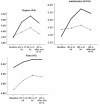Effect of vitamin E with and without saffron on the sexual function in women of reproductive age with sexual dysfunction: a randomized controlled trial
- PMID: 38408971
- PMCID: PMC10897983
- DOI: 10.1186/s12905-024-02980-w
Effect of vitamin E with and without saffron on the sexual function in women of reproductive age with sexual dysfunction: a randomized controlled trial
Abstract
Background: Sexual satisfaction is a crucial part of a fulfilled life, and the ability to have satisfying sexual function is crucial to one's sexual health. This study investigated the effect of the combined administration of saffron and vitamin E and vitamin E alone on the sexual function of women in their reproductive years.
Methods: A triple-blind randomized controlled trial was conducted with 50 participants experiencing sexual dysfunction without comorbid sleep disorders or severe depression. They were allocated into two groups using a block randomization method (stratified based on the severity of moderate or mild/normal depression). During the 8-week intervention period, participants in the experimental group were administered a 15 mg saffron capsule (safrotin) in the morning and a combination capsule containing 15 mg saffron and 50 mg vitamin E (safradide) in the evening. During the same period, the control group consumed one saffron placebo capsule in the morning and one capsule containing 50 mg of vitamin E and saffron placebo in the evening (in identical appearance to safradide). The Female Sexual Function Index was used to assess sexual function, and the Depression, Anxiety, and Stress Scale-21 (DASS-21) was used to measure levels of depression, anxiety, and stress. These measures were administered at baseline as well as four and eight weeks post-intervention, with an additional measurement taken four weeks after the intervention ceased. The repeated measures ANOVA, ANCOVA, and Mann-Whitney U tests were used to compare the groups.
Results: Following the intervention, the experimental group (saffron and vitamin E) demonstrated a statistically significant increase in the overall mean score of sexual function compared to the control group (placebo of saffron and vitamin E) (adjusted mean difference (AMD): 4.6; 95%CI: 3.1 to 6.1; p < 0.001). The mean scores for sexual function dimensions, namely libido, arousal, orgasm, and satisfaction, except for pain, were consistently higher than those of the control group across all time points (p < 0.001). Additionally, the mean score for lubrication was significantly higher only at the eighth-week measurement (p = 0.004). The mean depression score in the experimental group was significantly lower than in the control group at all-time points, i.e., four (p = 0.011) and eight weeks after the intervention (p = 0.005), and four weeks after the end of the intervention (p = 0.007). The experimental group exhibited a statistically significant decrease in mean anxiety score compared to the control group at four weeks into the intervention (p = 0.016) and four weeks following the end of the intervention (p = 0.002). At eight weeks post-intervention, however, there was no significant difference between the groups (p = 0.177). Additionally, the experimental group exhibited a significant reduction in the overall mean stress score compared to the control group after the intervention (AMD: -2.3; 95%CI: -3.1 to -1.5; p < 0.001).
Conclusion: Using the combination of saffron and vitamin E is more effective in improving sexual function and its domains compared to vitamin E alone in women of reproductive age with sexual dysfunction without severe depression. Also, it diminishes the degree of depression, anxiety, and stress more compared to vitamin E alone. However, further research is required to arrive at a more definitive conclusion.
Trial registration: Iranian Registry of Clinical Trials (IRCT): IRCT20100414003706N36. Date of registration: 17/05/2020; URL: https://en.irct.ir/trial/45992 ; Date of first registration: 21/05/2020.
Keywords: Saffron; Sexual dysfunction; Vitamin E; Women of reproductive age.
© 2024. The Author(s).
Conflict of interest statement
The authors declare no competing interests.
Figures
Similar articles
-
The effect of intra-vaginal oxytocin on sexual function in breastfeeding mothers: a randomized triple-blind placebo-controlled trial.BMC Pregnancy Childbirth. 2022 Jan 22;22(1):62. doi: 10.1186/s12884-022-04384-w. BMC Pregnancy Childbirth. 2022. PMID: 35065634 Free PMC article. Clinical Trial.
-
The effect of oral capsule of curcumin and vitamin E on the hot flashes and anxiety in postmenopausal women: A triple blind randomised controlled trial.Complement Ther Med. 2020 Jan;48:102267. doi: 10.1016/j.ctim.2019.102267. Epub 2019 Nov 26. Complement Ther Med. 2020. PMID: 31987231 Clinical Trial.
-
Saffron for treatment of fluoxetine-induced sexual dysfunction in women: randomized double-blind placebo-controlled study.Hum Psychopharmacol. 2013 Jan;28(1):54-60. doi: 10.1002/hup.2282. Epub 2012 Dec 20. Hum Psychopharmacol. 2013. PMID: 23280545 Clinical Trial.
-
The effect of probiotics on mood and sleep quality in postmenopausal women: A triple-blind randomized controlled trial.Clin Nutr ESPEN. 2022 Aug;50:15-23. doi: 10.1016/j.clnesp.2022.06.005. Epub 2022 Jun 9. Clin Nutr ESPEN. 2022. PMID: 35871917 Clinical Trial.
-
Novel Augmentation Strategies in Major Depression.Dan Med J. 2017 Apr;64(4):B5338. Dan Med J. 2017. PMID: 28385173 Review.
References
-
- World Health Organization. Defining sexual health 2002 [cited 2023 Jun 18]. Available from: https://www.who.int/reproductivehealth/publications/sexual_health/defini...
Publication types
MeSH terms
Substances
LinkOut - more resources
Full Text Sources
Medical
Research Materials




